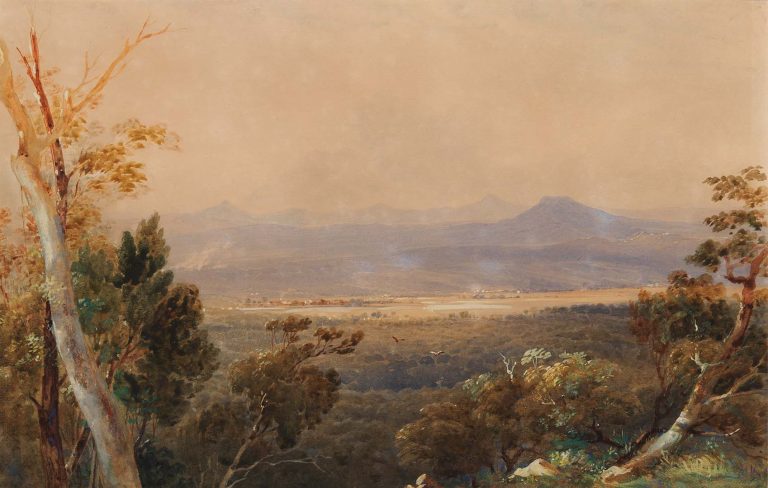We acknowledge the Traditional Owners of the land on which the Queensland Art Gallery | Gallery of Modern Art stands and recognise the creative contribution First Australians make to the art and culture of this country.

Conrad Martens / England/Australia 1801–78 / Franklyn Vale c.1854 / Watercolour / 29.4 x 45cm / Purchased 2000. The Queensland Government’s special Centenary Fund / Collection: Queensland Art Gallery
Conrad MartensFranklyn Vale c.1854
Not Currently on Display
Conrad Martens’s Franklyn Vale c.1854 conveys the sense of a distinctly ‘Australian atmosphere’ very early in the history of landscape painting in this country. The translation of the distant hills to a high key blue is a peculiarly Australian feature usually associated with the Heidelberg School impressionists some thirty years later. The dark shading of the gum trees in the foreground creates a strong contrast with the lighter mountains and sky, demonstrating Martens’s skill and handling of distance.
Conrad Martens visited the squatter’s run Franklyn Vale on the Darling Downs during his visit to Queensland in 1851–52, following the economic depression in Sydney during the 1840s. He was hoping for commissions from the wealthy squatters, some of whom he had also known in Sydney. Martens completed many sketches and watercolours of the Franklyn Vale homestead and surrounding views.
This work is a view of the head station of Franklyn Vale, looking east from the northern spur of Mount Beau Brummell, with Mount Walker on the right horizon.
Conrad Martens was born at Crutched Friars, near the Tower of London, in 1801, to a German father and English mother. At the age of 16, he became a pupil of English landscape painter Anthony Vandyke Copley Fielding.
After working as a topographical artist on the Hyacinth, in 1833 Martens met Robert FitzRoy, captain of the British vessel HMS Beagle, and FitzRoy engaged him as the ship’s artist. During the voyage, Martens established an enduring friendship with famous naturalist Charles Darwin. The artist later disembarked in Chile and made his own way to Australia via Tahiti.
Settling in New South Wales in 1835, Martens achieved immediate and enduring recognition as the most proficient and prolific landscape artist in the Australian colonies. He sailed north to Brisbane in late 1851, where he received many commissions, travelling through the Darling Downs at a time of early European settlement in the region.
In the early 1860s, Conrad Martens took a position at the Parliamentary Library to make ends meet, and while this curtailed the time he could spend on his art, he was commissioned for two major public works and also entered the Paris International Exhibition in 1867. He continued to paint until a few days before his death in 1878.
Endnotes:
See Elizabeth Ellis, ‘The life of Conrad Martens’, Queensland Visual Arts Online, Queensland Art Gallery, Brisbane, accessed online 27 April 2017.